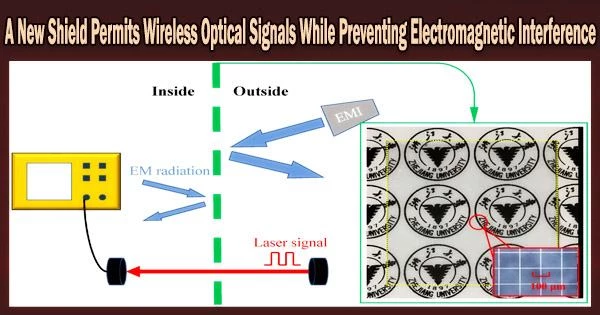Electromagnetic interference (EMI) is the disturbance that affects an electrical circuit due to either electromagnetic induction or electromagnetic radiation emitted from an external source. The new shield is designed to block EMI while still permitting wireless optical signals, such as those used in fiber optic communications, to pass through.
For the first time, a mechanically flexible silver mesh that is apparently transparent, permits high-quality infrared wireless optical communication, and effectively blocks electromagnetic interference in the microwave radio area has been experimentally shown by researchers.
Many devices depend on optical communication channels to function, and these channels are frequently employed for remote sensing and detection.
The modern household, factory floor, and healthcare facility all contain electronic equipment. To stop electromagnetic radiation from these devices from interfering with one another and degrading device performance, electromagnetic interference shielding is frequently utilized.
The optical communication channels required for remote sensing, detection, or activation of the devices can potentially be blocked by electromagnetic shielding, which is also employed in the military to conceal tools and vehicles from the adversary.
Device performance could be improved in a range of civil and military scenarios with the use of a shield that can suppress interference while permitting optical communication pathways.
“Many conventional transparent electromagnetic interference shields allow only visible light signals through,” said research team leader Liu Yang from Zhejiang University in China. “However, visible wavelengths are not well suited for optical communication, especially free-space or wireless optical communication, because of the huge amount of background noise.”
In the journal Optical Materials Express, the researchers describe their new mesh. They demonstrate that it can achieve a high average electromagnetic shielding effectiveness of 26.2 dB in the X band when mixed with clear silicone and polyethylene, as well as good optical transmittance at a variety of wavelengths, including those in the infrared.
Because the physical parameters for our mesh can be easily optimized by changing the grid period, line width and thickness, it is easier to achieve well-balanced optical, electrical and electromagnetic properties compared with what is possible with other kinds of transparent conductive films such as silver nanowire networks, ultrathin metallic films and carbon-based materials.
Liu Yang
“We take the advantage of the ultrabroad transparency and low haze of a metallic micromesh to demonstrate efficient electromagnetic shielding, visible transparency and high-quality free-space optical communication,” said Yang. “Sandwiching the mesh between transparent materials improves the chemical stability and mechanical flexibility of the silver mesh while also imparting a self-cleaning quality. These properties will enable our silver mesh to be applied widely both indoors and outdoors, even on corrosive and free-form surfaces.”
A flexible and transparent mesh
The new silver mesh was created by researchers using a translucent and flexible polyethylene substrate and a repeating square grid pattern. By releasing stress during bending, the continuous grid structure of the silver mesh makes it extremely flexible. The opening ratio, which is a measurement of the size of the mesh’s holes, plays a major role in determining the transparency of the silver mesh, making it wavelength-independent.
“A large opening ratio, for example, is beneficial for a high, broadband transparency and low haze but is detrimental to high conductivity and thus electromagnetic shielding performance,” said Yang. “Because the physical parameters for our mesh can be easily optimized by changing the grid period, line width and thickness, it is easier to achieve well-balanced optical, electrical and electromagnetic properties compared with what is possible with other kinds of transparent conductive films such as silver nanowire networks, ultrathin metallic films and carbon-based materials.”
To demonstrate their new technology, the researchers fabricated a silver mesh onto a polyethylene substrate. The mesh had a grid period of approximately 150 μm, a grid line width of approximately 6 μm and a thickness that ranged from 59 to 220 nm. This was then covered with a layer of 60-μm thick polydimethylsiloxane.
The resulting film showed high transmission for a broad wavelength range from 400 nm to 2000 nm and sheet resistance as low as 7.12 Ω/sq, allowing a high electromagnetic shield effectiveness up to 26.2 dB in the X band. The researchers also showed that the film could shield low-frequency mobile phone signals.
The researchers note that there is still much opportunity for improvement because this study is simply a prototype demonstration. For instance, employing more conductive materials would increase the effectiveness of electromagnetic shielding, while using more transparent and haze-free materials would increase both the visible transparency and the quality of free-space optical communication.
In order to extend FSO communication to longer wavelengths, where air interference is reduced and improved communication quality may be attained, they are also investigating mid-infrared transparent conductive materials. The mesh would also need to be less expensive and easier to install in order to be commercialized.















